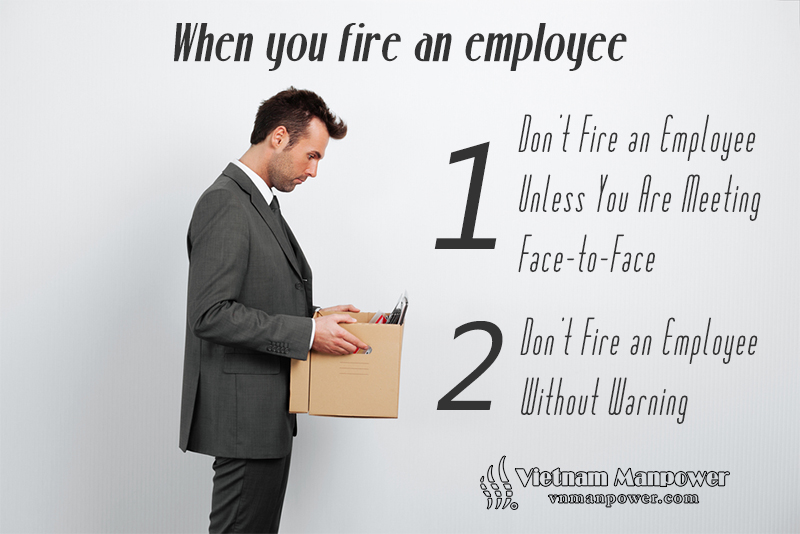
Economic downturns have led various enterprises in many industries, especially construction and oil & gas, to unavoidable downsizing situations. Reducing workforce is extremely difficult, not only for laid-off employees but also for employers, HR professionals, and remaining employees. If you do it wrong, downsizing can destroy the image of your company, employer brand and the morale of survivors. HR managers, senior managers, and decision-makers need to plan carefully the whole downsizing process to keep all stakeholders on the right track after mass layoffs.
The ways you treat laid-off people mirror company's attitudes towards its staff in the future. Thus, a good downsizing plan must pay attention to both laid-off and surviving employees to ensure the sake of all stakeholders.
1. Be transparent and open to employees

Obviously nobody welcome layoffs, but sometimes we have no alternative option. When it comes to massive layoffs, leaders and HR professionals should address clearly the needs of the downsizing. In face-to-face meetings, you shouldn't avoid talking about the company's current bad financial situation or other problems. Be honest and transparent because they deserve to know the truth even it's not pleased to talk or hear. A direct and transparent approach shows your respect to employees, even when they have to leave soon.
2. Respect the law and downsize with dignity

Different countries have different Labor and Employment Laws, but they all prioritize employees' rights. You should respect for what they intend as well as what they prescribe or proscribe unless you want to find yourself in some future legal troubles. However, dignity and humanity should be kept in every single decision during downsizing process. It's time to put yourselves in employees' shoes to understand what they really need when you suddenly let them go. Visionary leaders can realize the signs of downturns early and prepare to cope with the bad situation to minimize all costs, including layoffs. Exit incentives may costly but it can ease both gone and remaining employees' mind in the long run.
3. Focus on helping rather than hurting

A company with great employees-centered corporate culture will try to identify the needs of their employees to give suitable support. Downsizing is always a sensible and difficult decision. Each employee may react differently to the announcement. Not all of them find it easy to accept the fact that they have lost their jobs in spite of doing nothing wrong! It's not the time to blame anyone for the decision because it may help managers avoid the criticism immediately but won't help resolve the issue at all. It's better to stay engaged and help the layoffs in a supportive manner. HR professionals should play the most active role in healing the pain of laid-off employees. The care, appreciation, and gratitude for former employees and their contributions are crucial things that the company needs to express during the whole downsizing process. Moreover, employers and managers should support them on their next jobs by giving good recommendation letters, introducing them to other potential employers in the industry or outplacement consultants. Whatever you do, remember to treat them with full respect they deserve to receive during their transitions.
4. Support and motivate survivors
.jpg)
Not only laid-off employees but also survivors need support when it comes to downsizing. The way you conduct your cutting plan may make or break the morale and engagement of the remaining workforce. Could you imagine how they feel when observing their colleagues going in bulk? Along with coping with downsized employees, you should also keep an eye on the survivors. Be honest and open to them about the reasons of downsizing decision and the needs for all remaining stakeholders to move on and overcome the hard time. You need to talk with each of them individually and let them tell you their thoughts and concerns. One-to-one direct meetings can also let surviving employees know that they stay for a reason and how they are valued. Anything you can do to make them feel their stay is a win-win deal for you, as the employer, and for them, as valued contributors.

Also, gaining the trust after downsizing is a must because your employees have experienced a huge loss which caused by the company anyway. The downsized company will require its workforce to handle more tasks with more responsibilities. Thus, it's a good time for additional training provided by the company, which creates more opportunities for survivors' career development at the same time.
Re-engaging employees after a downsizing is not easy because they may face overwhelmed workload, work stress or even fear of the next downsizing decision. Allow them time and space to adapt to the new situation, but never leave them alone. Your thoughtful planning and deliberate actions will bring committed workforce back or not, it depends on your choice!












Replies to This Discussion